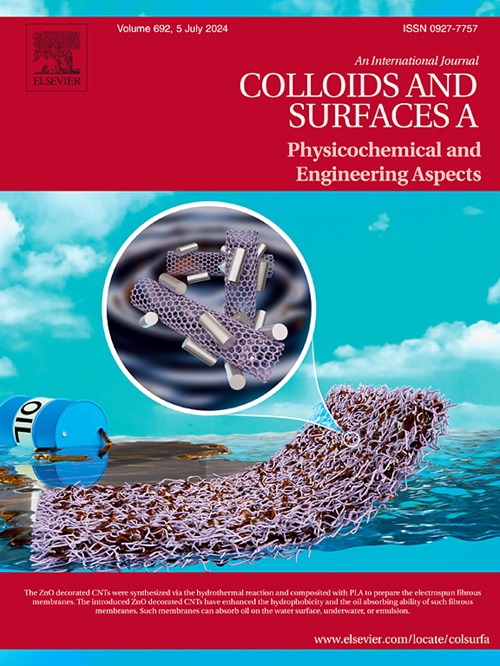Effect of soluble alcohol on the foamability of silica nanoparticles in combination with quaternary ammonium surfactant
IF 4.9
2区 化学
Q2 CHEMISTRY, PHYSICAL
Colloids and Surfaces A: Physicochemical and Engineering Aspects
Pub Date : 2025-04-01
DOI:10.1016/j.colsurfa.2025.136779
引用次数: 0
Abstract
Surfactants are essential for the formation of Pickering foams (PFs), particularly in the flotation of mineral particles. With their hydroxyl and alkyl groups, soluble alcohols play a significant and complex role in the adsorption of surfactants at interfaces. The synergistic effect of soluble alcohol on PFs and its impact on the competitive adsorption of surfactants at gas-liquid and solid-liquid interfaces are well recognized. This study aimed to evaluate the influence of soluble alcohol on PFs stabilized by negatively charged hydrophilic silica nanoparticles (SNPs), which are made hydrophobic by cationic surfactants. A surface tension meter, contact angle (CA) meter, and turbidimeter were used to assess the adsorption process. The results demonstrated that moderate levels of soluble monohydroxy alcohol enhanced the adsorption and orderly arrangement of surfactants at the particle interface, improving the hydrophobicity of the particles and promoting foaming. The data indicated that surfactants or monohydroxy alcohols with longer hydrophobic chains are more effective at promoting foamability and adsorption. However, soluble alcohols with higher hydroxyl densities did not significantly increase foamability. Preliminary flotation trials with quartz also confirmed that propanol positively influences the formation of PFs, indicating practical relevance. These findings provide deeper insights into the soluble monohydroxy alcohol-enhanced competitive adsorption mechanisms of surfactants at both the solid-liquid and gas-liquid interfaces, contributing to the development and potential applications of PFs in mineral particle flotation.
求助全文
约1分钟内获得全文
求助全文
来源期刊
CiteScore
8.70
自引率
9.60%
发文量
2421
审稿时长
56 days
期刊介绍:
Colloids and Surfaces A: Physicochemical and Engineering Aspects is an international journal devoted to the science underlying applications of colloids and interfacial phenomena.
The journal aims at publishing high quality research papers featuring new materials or new insights into the role of colloid and interface science in (for example) food, energy, minerals processing, pharmaceuticals or the environment.

 求助内容:
求助内容: 应助结果提醒方式:
应助结果提醒方式:


